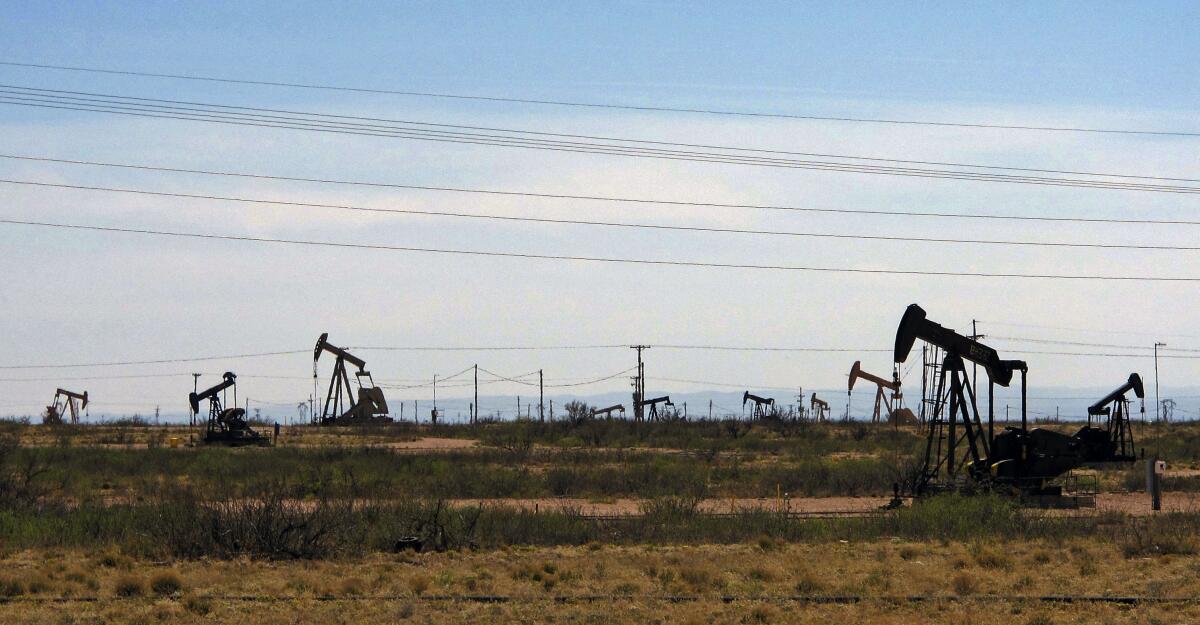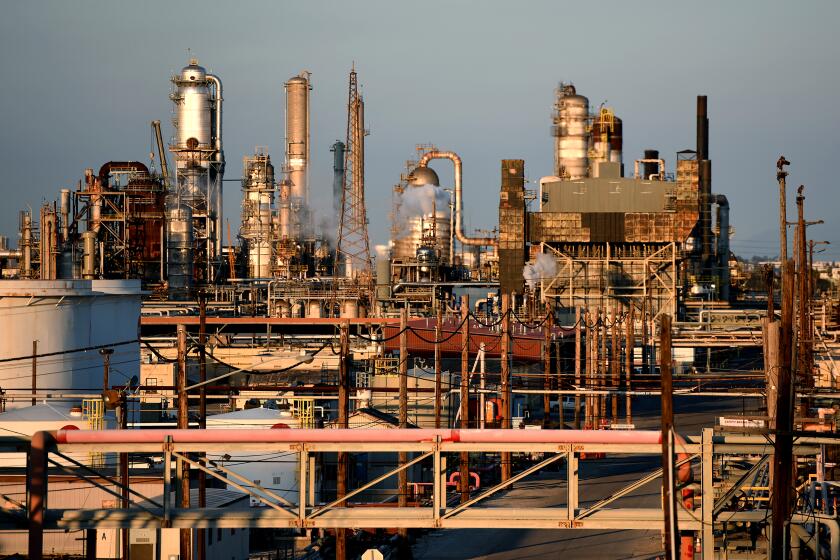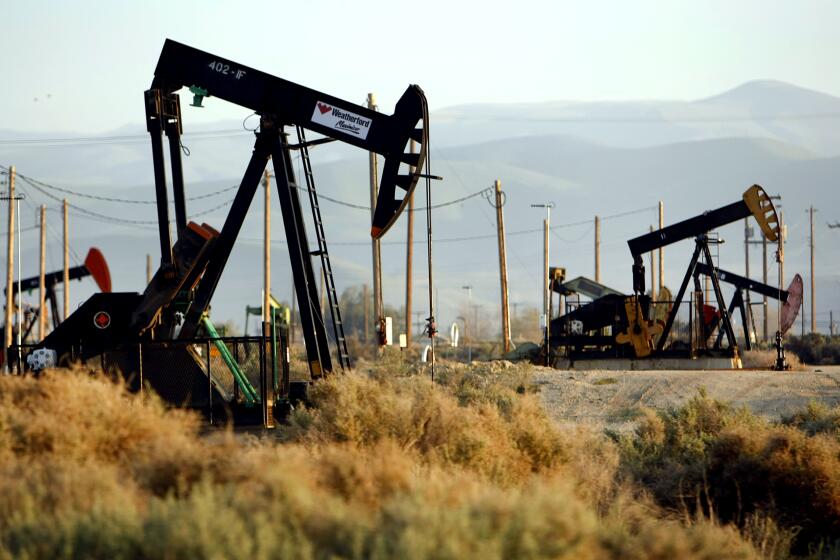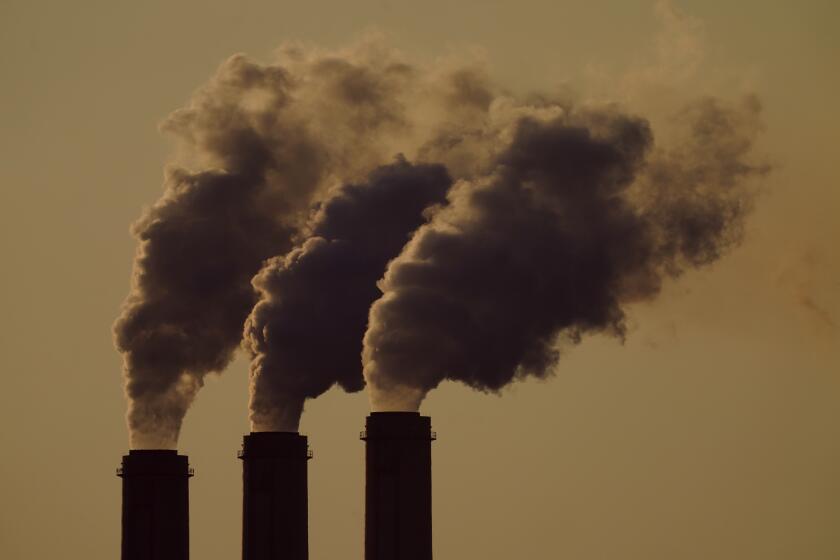Energy-producing states struggle to replace fossil fuel tax revenue

- Share via
SANTA FE, N.M. — Government budgets are booming in New Mexico: Teacher salaries are up, residents can go to an in-state college tuition-free, moms will get medical care for a year after childbirth, and criminal justice initiatives are being funded to reduce urban violence.
The reason behind the spending spree? Oil. New Mexico is the No. 2 crude oil producer among U.S. states and the top recipient of U.S. disbursements for fossil fuel production on federal land. But a budget flush with petroleum cash has a side effect: It also puts the spotlight on how difficult it is to turn state rhetoric on tackling climate change into reality.
State governments in the nation’s top regions for producing oil, natural gas and coal have by far the highest per-capita reliance on fossil fuels — led by Wyoming, North Dakota, Alaska and New Mexico. The revenue bankrolls essential public services, from highway maintenance to prisons. In Carlsbad, N.M., oil infrastructure property taxes are underwriting a high school performing arts center, expanded sports facilities and elementary school renovations.
None of that would be possible without oil revenue, said schools Supt. Gerry Washburn.
“We can’t slow down in that area and what we do to fund schools until we have a legitimate replacement” for oil and natural gas income, he said. “Whether you’re in the middle of the oil patch or in an area with no oil and gas drilling going on, those policies are going to impact revenue in every school district in the state.”
Federal, state and local governments receive an estimated $138 billion a year from the fossil fuel industry, according to a study from the Washington-based nonpartisan economics group Resources for the Future, which does not advocate on energy policies. That’s equivalent to the annual state spending of New York and Texas combined.
The cashflow is dominated by gasoline and diesel retail taxes in every state, but energy-producing states have the deepest dependence on fossil fuel income through a gamut of taxes, royalties, lease sales and fees. Because that revenue helps pay for government services, they tend to tax residents less, said Daniel Raimi, a fellow at Resources for the Future and co-author of the study.
There’s a giant gap between what many companies have pledged and what’s actually needed.
“That’s a really challenging dynamic if you think about a shift away from fossil fuels,” he said. “They’re going to be faced with the question: Do we raise our taxes on our residents or do we reduce the level of services we provide?”
In New Mexico, oil and gas account for 42% of state government income, a share that is rising amid the war in Ukraine and record-setting oil production in the Permian Basin that stretches across southeastern New Mexico and western Texas. Additional oil income flows to a new interest-bearing trust for early childhood education.
Soaring fossil fuel industry profits also allowed the Democratic-controlled New Mexico Legislature to try to tackle the highest-in-the-nation unemployment rate and persistently high poverty. Lawmakers provided $1.1 billion in tax relief and direct payments of up to $1,500 per household to offset inflation.
At the same time, legislators balked this year at climate initiatives that might restrain petroleum production. They rejected a bill to limit climate-warming pollution in the production and distribution of transportation fuels, a step taken by West Coast states. New Mexico also shunned a state constitutional amendment for the right to clean air.
Democratic Gov. Michelle Lujan Grisham, up for reelection in November, said her administration is working to contain oilfield methane pollution and diversify the economy. New mandates call for electricity production from solar, wind and other renewable sources. But she has cautioned the federal government against significant restrictions on oil exploration and production, still the lifeblood of the state budget.
“We can work very effectively with oil and gas producers to both meet clean energy standards ... while still managing pretty incredible exploration of fossil fuels to meet the current energy demands of the world,” the governor said in April.
California’s insurance commissioner has issued a new report comparing insurance companies’ investments in fossil fuels and clean energy.
Preserving income from oil, natural gas or coal production while acting on climate change can be especially tricky in blue states where Democrats often campaign on tackling global warming.
Colorado’s Democratic Gov. Jared Polis is pursuing an ambitious clean-energy plan while trying to preserve $1 billion in annual oil and gas production tax revenue. To justify air pollution restrictions, Polis has cited real-time evidence of climate change, drought and fire.
But Polis, a wealthy tech entrepreneur, last year threatened to veto a proposal that might impose per-ton emission fees on polluters. William Toor, executive director of the governor’s Colorado Energy Office, said the state’s not targeting fossil fuel production — only the industry’s emissions.
On Colorado’s northeastern plains, Weld County Commission Chairman Scott James said state regulations stifle new drilling needed to support production and government revenue, especially for schools. The county is centered on a vast oil field stretching from the Denver area into Wyoming and Nebraska.
“I agree with the overall mission of reducing greenhouse gas, but there’s an environment that exists at the state Legislature that we must electrify everything, we must mandate it, we must do it now,” James said. “And these technologies are not yet ready for prime time. We simply don’t have the capacity to do it.”
Rural and economically isolated communities could find it hardest to adapt to a low-carbon economy, said Montana-based Headwaters Economics researcher and economist Kristin Smith, who studies public finances in North Dakota’s Bakken oil region. She anticipates “very hard decisions” about cutting areas like public health care and policing.
A U.N.-backed study says the world must cut its production of coal, oil and gas by more than half in the coming decade to hit global warming targets.
Some major petroleum-producing states are forging ahead with their climate agendas.
Pennsylvania in April became the first major fossil fuel state to adopt a carbon-pricing policy, joining an 11-state regional consortium that sets a price and declining limits on carbon dioxide emissions from power plants.
Democratic Gov. Tom Wolf’s initiative comes without approval from the Republican-controlled Legislature in the nation’s No. 2 state for natural gas production — and a major exporter of gas-generated electricity. A per-well drilling fee on the state’s booming Marcellus Shale gas industry has rained cash on rural counties and municipalities for nearly a decade.
South of Pittsburgh, Washington County reaped over $100 million in the last decade. That’s equivalent to $500 per resident — a “game changer,” said county board Chairwoman Diana Irey Vaughan. The windfall paid for park and bridge improvements, among others.
Democratic state Rep. Greg Vitali, an advocate for stronger climate change action, said local governments relying on gas drilling money will simply have to use traditional tools such as property taxes to get by.
Republican-dominated Wyoming, the top coal-production state, has bold goals to reduce greenhouse emissions to less than zero even while fossil fuels account for over half its revenue.
That vision relies on eventually capturing carbon dioxide from coal- and gas-fired power plants and pumping it underground, possibly to increase oil production in aging fields in the middle of the state. Wyoming leaders are also looking to alternative fuels such as hydrogen and nuclear power, using reactors that produce less waste.
Meanwhile, a decade of declining coal demand has sapped government income. Republican Gov. Mark Gordon in March signed a coal-tax reduction, forgoing about $9 million annually to help the coal industry stay economically viable.
The state — one of only two with no taxes on individual income, corporate income or gross receipts — must confront its dependence on fossil fuel money eventually, said Jennifer Lowe, executive director of the Equality State Policy Center, a government watchdog group.
“At some point, there’s going to have to be a come-to-Jesus moment,” Lowe said.
Gruver reported from Cheyenne, Wyo. Associated Press writers Jim Anderson in Denver and Marc Levy in Harrisburg, Pa., contributed to this report.
More to Read
Sign up for Essential California
The most important California stories and recommendations in your inbox every morning.
You may occasionally receive promotional content from the Los Angeles Times.













